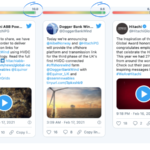So you’ve been doing competitive intelligence, either on your own or with a tool, but what exactly do you do with it? How is it helpful? The answer to these questions can vary depending on what your job is. Ideally all this information would be shared with these four teams: marketing, sales, product development, and human resources.
The marketing team cares because knowing what the competition is doing tells them a lot about what your target audience cares. It also tells them where that audience is hanging out. The sales team finds competitive intelligence valuable because they can use it to hook a new prospect. They’re able to understand how your company is better and can quickly react when a prospect mentions a competitor. Product developers can make adjustments and changes to the roadmap based on what your competition is doing. Why should human resources care? Well, if you’re trying to stay competitive in the talent market then it’s extremely valuable. Knowing what benefits and perks your competitors are offering employees, what acquisitions are happening in the industry, and if a company announces major layoffs can impact your recruiting strategy.
Now, let’s break down each of these 4 teams a bit further.
Marketing Team
The marketing team is probably who monitors competitors the most and you’re probably a marketer if you’re reading this. (If you’re not, shoot us an email and let us know!) If your focus is in digital then you’re probably constantly checking to see where you stack up against your competition. You’re looking at social following, social engagement, content creation, etc. Knowing what content your competitors are cranking out gives you insight into their SEO strategy. Seeing what they push out on social media lets you know what content they think their audience wants to see. Knowing what content they’re creating for their blog or sending in their emails tells you what their campaigns are probably focused on right now.
Knowing what the competitors are doing on social can help you decide what social channels to focus on.
Sales Team
A 2018 study by LinkedIn and the Content Marketing Institute found that 80% of content created by marketing teams is not used by sales teams. This percentage has increased greatly over the 2014 study by Qvidian that found over 40% of marketing content went unused by sales. Why does all this content go unused? Sales teams are unable to locate or access the materials and information. 88% of sales reps also believe that they’ve missed opportunities because they can’t leverage all the internal and external information.
Members of your sales team probably don’t want another tool that they have to login to. They already stayed logged into their calendar, their email, their CRM, and their membership groups. So asking them to also log into a CI tool is probably not going to work. Since they likely already live and breathe by their email, set them up with a quick daily or weekly email. A quick-to-digest recap of what the competition is creating, getting press about, talking about on social, and what content they’re creating is very valuable to your sales team.
Product Development
Product development cares about what your competition is selling, where they’re selling it, and how much they’re selling it for. Keeping tabs on marketing emails and social content can help decide on pricing and promotions. Your competition is likely highlighting any big price changes or new promotions in their emails and social platforms.
Product development will also use competitive intelligence information to decide what new products to add to the roadmap and what products could probably be discontinued. If a competitor is releasing products more frequently or making updates to existing products, the product development team needs to know about it.
Human Resources
Depending on how niche of an industry you work in, talent acquisition and talent retention can be challenging. In 2018, 2.4% of the entire US workforce voluntarily quit their job, the highest it’s been in 17 years. That’s 3.58 million people who were looking for new opportunities less than 2 years ago. It’s worthwhile investing in an employee who already has an understanding of your industry so that you’re not having to onboard them to your company and your industry at the same time.
Competitive intelligence is useful for HR because it’s important to know what your competitors culture is like and what benefits/perks they’re offering employees. This helps you stay competitive both in hiring talent and keeping the talent you already have. It’s also important to keep track of any big moves affecting the workforce such as an acquisition/merger or any major layoffs. 20% of employees voluntarily leave a company after a merger announcement. So being alerted as soon as a merger is announced can make a huge difference in your ability to pick up some of that talent.
Competitive analysis can be time-consuming if you’re doing it all manually, on the flip-side, it can be an investment if you’re using tools to help pull all the information. Either way, you want to make sure that you’re taking full advantage of the competitive intelligence that you’re collecting. Too often competitive data is only used by the marketing team and not shared with other areas of the company who could also find it beneficial too.
Dashboards and email digests make it easy to share competitive intelligence information with multiple people across various teams. If you’d like to check out ours, we’d love to show you a demo dashboard. You can book a 12 minute demo here.


